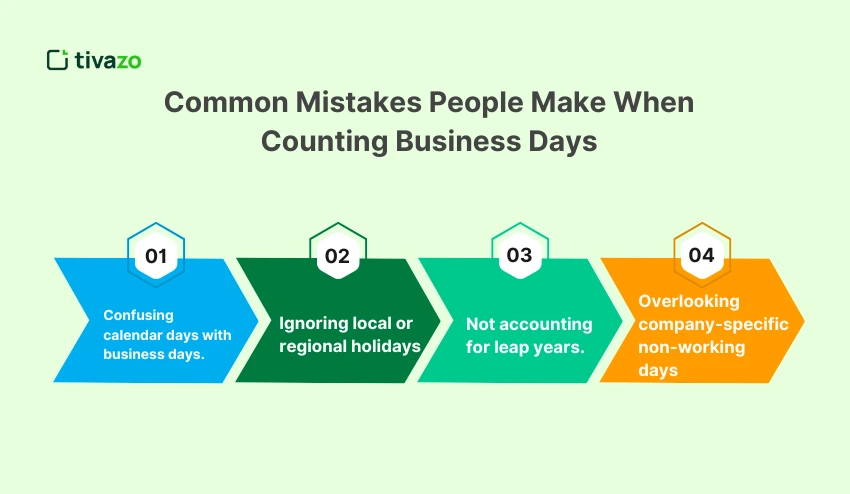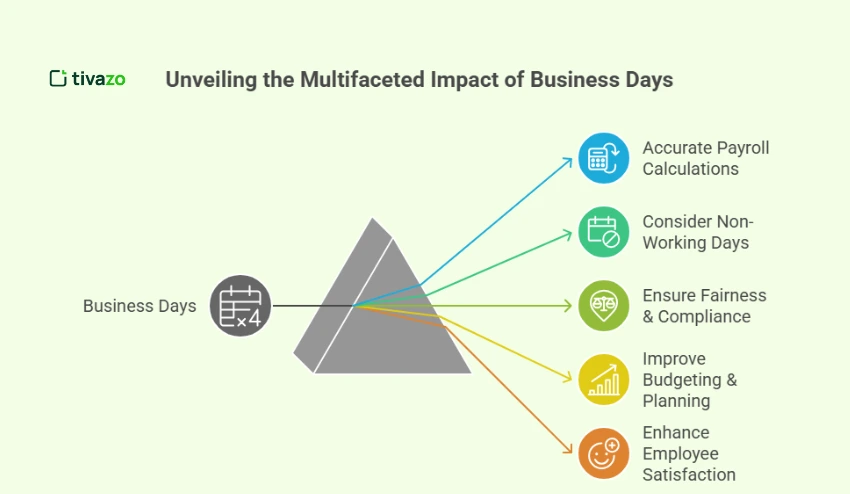If you’ve ever wondered how many business days in a year, you are not alone at all. Knowing how many business days are in a year can have a significant influence on payroll, project deadlines, resource planning, and employee productivity in general. Surprisingly, many professionals and businesses don’t think to consider the actual number of working days in a year, deducting for any holidays, as well as accounting for regional variables such as weekends and public holidays.
In this guide, you will learn what business days are, how they differ from calendar days, and how to accurately calculate the business days within a year, including considerations for leap years and holidays. You will understand why this information is important to HR teams, project managers, and employee productivity. Finally, we’ve prepared some practical tips and tools to help you track and manage your business days in a calendar year, so you can plan better and improve productivity in the year to come.
Key Highlights:
- Business Days in a Typical Year
- Impact of Holidays and Paid Time Off on Business Days in a Calendar Year
- Leap Year Changes in Business Days
- Best Practices to Manage Business Days
- Mistakes People Make When Counting Business Days
- The Role of Business Days in Payroll and Compensation
What Exactly Are Business Days?
Before diving into the numbers, it’s crucial to clarify what business days are. Business days are normally Monday through Friday, excluding weekends or public holidays — that is, the days that your office is open for business and work is performed.
Calendar days are all days in the year or, potentially, all days across the world (even if there are time differences), counting all weekends and holidays. Working days normally mean the same as business days, but can sometimes include Saturdays, depending on the part of the world or industry.
Because business days exclude weekends and public holidays, if you have 10 public holidays in your country or jurisdiction, that cuts 10 total business days from your total number of business days in a calendar year.
It’s helpful to know these distinctions when you want to accurately calculate business days in a year or how many business days in a year you have available for scheduling and planning.
How Many Business Days in a Year?
The basic formula for business days is:
52 weeks × 5 business days per week = 260 business days in a calendar year
This assumes:
- No holidays
- A Monday-to-Friday workweek
- No regional or company-specific days off
In reality, though, things are rarely straightforward, so the number of total working days in a year, excluding holidays, may be lower depending on your location.
The Impact of Holidays and Paid Time Off on Business Days in a calendar year
Public holidays, as well as paid time off, are significant reducing factors when calculating how many business days in a calendar year there are. Each country has a different number of public holidays, typically between 5 and more than 15 days per year. Generally, public holidays for employees and businesses are just that – holidays, meaning they will not be counted when you calculate business days in a calendar year.
For instance, if you observed 10 public holidays, you would subtract the holidays from the 260 days in a year, and you would end up with approximately 250 days. In addition, paid time off (PTO), sick leave, or other leave, depend on the company, and working days in a year, excluding holidays, and, therefore, the actual days that could be available for work, are also likely to be a lower number of days.
Businesses should take these days into account to avoid overestimating much available work time, and for project and payroll planning purposes. Noting down these factoring changes can help increase efficiency for scheduling work and employee satisfaction.
Leap Years: What Changes in Business Days?
A leap year has 366 calendar days instead of 365, thanks to the 29th February.
How does that affect business days?
- Leap years mean an additional day, and that day could be a weekday or a weekend.
- If the day is a weekday, you gain 1 business day (that is 261 business days).
- If it’s a weekend, your business days are the same.
Best Practices to Manage Your Business Days Like a Pro
The best practices for managing how many business days in a year your team has are important. Tracking your company’s calendar year of business days, in the end, is top priority, so operations and planning run smoothly. When we employ best practices, companies can make better decisions. Managing tax and operating expenses correctly and increasing productivity, teams can use all the resources available to them, stay organized, and increase profits while avoiding incidents in these tough working conditions.
Clearly defined rules and resources can provide teams and organizations with context and orders aligned with the reality of working days in the calendar year (and keeping in mind time off and the holidays). Updating, amending, and adjusting your calendar regularly to meet the current direction of policies or unexpected absences can help create a better workflow for the company.
Arguably more critical is positively creating a workplace decision for employees than negatively influencing them by wasting time and resources, fostering uncertain expectations, and less engagement.

- Keep Your Calendar Updated
- Include all your holidays and time off to stay accurate always.
- Communicate Clearly
- Always set and share business day expectations with your team.
- Use Automated Tools
- Prevent possible errors with business day calculators and apps.
- Plan for Unexpected Absences
- Factor in sick days and major emergencies in your schedule.
- Review Annually
- Update your calendar yearly, especially in leap years.
Why Knowing Business Days Is Crucial for Your Business
This information about how many business days in a year is very useful to any business that wants to operate efficiently. For example, knowing the accumulation of business days in a calendar year accurately helps improve payroll responsibilities by improving salary construction and calculating overtime, and allows a manager to set realistic project timelines to meet deadlines, and is reflective of weeks worked that account for weekends, holidays, and other non-business days.
Knowing the exact number of business days in a year, fewer holidays allow for more accurate resource scheduling and give insight into how teams can be optimally matched for work hours based on actual available time. Ultimately, knowing how to work positively affects work output. This type of awareness allows for prospective workloads and breaks throughout the year, reducing employee burnout and better utilizing productivity.
Conversely, ignorance could lead to increased operating expense if time spent producing is not managed well, and could increase the risk of missed deadlines. Therefore, if you don’t proactively manage the time and resources a business has, your business will be at risk!
Common Mistakes People Make When Counting Business Days
It’s easy to make mistakes when determining how many business days you have in a year. Here are some examples: Thinking of business days in a calendar year compared to the number of total calendar days can often be an overestimate of the available workdays. Remember, there are also local or regional holidays that may often distort the true count of working days in a year, no holidays considered. Also, don’t forget to plan for leap years.
Not considering non-working days unique to your company, especially in terms of payroll, project timelines, and resources, can also produce planning errors. It’s important to be aware of some of the common mistakes, as they can become costly and inconvenient, and make sure your operations run smoothly and efficiently.

- Confusing calendar days with business days.
- Ignoring local or regional holidays.
- Not accounting for leap years.
- Overlooking company-specific non-working days.
By being aware and avoiding these errors, you can save money, time, and frustration!
How Different Industries and Countries Adjust Business Days
Various industries and countries modify the number of business days in a year based on their specific work environments and schedules. For example, various sectors such as retail and hospitality commonly operate on weekends, and so there are business days, so to speak, in a calendar year that go well beyond a calendar year of Monday through Friday.
Some countries work a shorter week than that, such as Sunday through Thursday, which impacts the count of standard working days in a year, as relevant to holidays. So when you account for business days, you need to focus on your industry schedule, regional cultural holidays as well as the added complexity of remote or global teams reporting across different calendars and/or time zones; all of which contribute not only to the accurate planning of business days.
How to Use Business Days to Improve Project Management
Knowing how many business days are in a year is important when managing projects. If managers are aware of how many business days are in a calendar year, they can assign more realistic and achievable completion dates for projects and avoid delays as a result of holidays and weekends. By considering the working days in a year (holidays generally excluded), teams can make informed decisions around task scheduling and resource allocations to accomplish their intended goals without missing deadlines.
Overall, using business days instead of calendar days creates increased clarity for all stakeholders and improves workflows, particularly when planning for the future. It can reduce stress levels for team leaders, prevent bottlenecks or frustration in the project work, and help with project success following reasonable processes.
The Role of Business Days in Payroll and Compensation
Payroll calculations rely upon the accurate count of business days in a year for a myriad of reasons. Generally speaking, employers need to know how many business days in a year employees are expected to work so that they can calculate wages, overtime, and benefits correctly. If an employer does not consider non-working days or holidays, or PTO, when calculating payroll, there may be miscalculations and dissatisfied employees.
Understanding how many days in a calendar year a workforce would be expected to work, generally excluding holidays, is an important consideration for any HR team to calculate wages, ensure fairness and compliance with wage-related laws, and help build trust with employees. Clarity on business days in a year can also improve organizational budgeting and planning for a financial year.

- Accurate Payroll Calculations
Know the number of business days in a year to make sure you are calculating pay and overtime correctly. - Consider Non-Working Days
Holidays, vacation, and PTO all need to be considered to avoid payroll mistakes. - Ensure Fairness & Compliance
Assists HR with compliance and accountability relative to labor laws and trust with employees. - Improve Budgeting & Planning
Business days assist with forecasting payroll expenses and planning related financial decisions. - Enhance Employee Satisfaction
Pay employees accurately, along with expectations and policies in written documents, leading to greater employee morale and retention.
How Technology Can Help You Track Business Days Effortlessly
Keeping track of how many business days there are in a year manually can be convoluted and error-prone. However, technology provides us with dozens of options that can make this simpler. Digital calendars, business day calculators, and productivity software provide an easy way to determine business days and include weekends, holidays, and company days off.
For instance, using tools will help bring together your focus management and precision scheduling, while also delivering peace of mind knowing you’ve never added up the business days incorrectly in a calendar year! Relying on technology allows organizations to not only decrease administrative efforts but also allows for more accuracy and assists organizations and employees with understanding realistic expectations surrounding work responsibilities and timelines for an entire business year.
Conclusion: Master Your Time, Master Your Business Days
Knowing exactly how many business days there are in a year is not only fun trivia, it is one of the best practices for more effective business management, productivity, & planning. Once you truly understand the concept, and get accurate at calculating business days, and you begin to use the smart tools available to you- from payrolls and project timelines, you can take that information and optimize just about anything.
FAQs
Do holidays count as business days?
No, public holidays are excluded from business days.
How do leap years affect business days?
Leap years add 1 extra day which may or may not be a business day.
What’s the difference between business days and working days?
Business days typically exclude weekends and holidays; working days may vary by company.
How can I calculate business days for my company?
Start with 260 days, subtract holidays, non-working days, and PTO. Use online calculators for accuracy.




